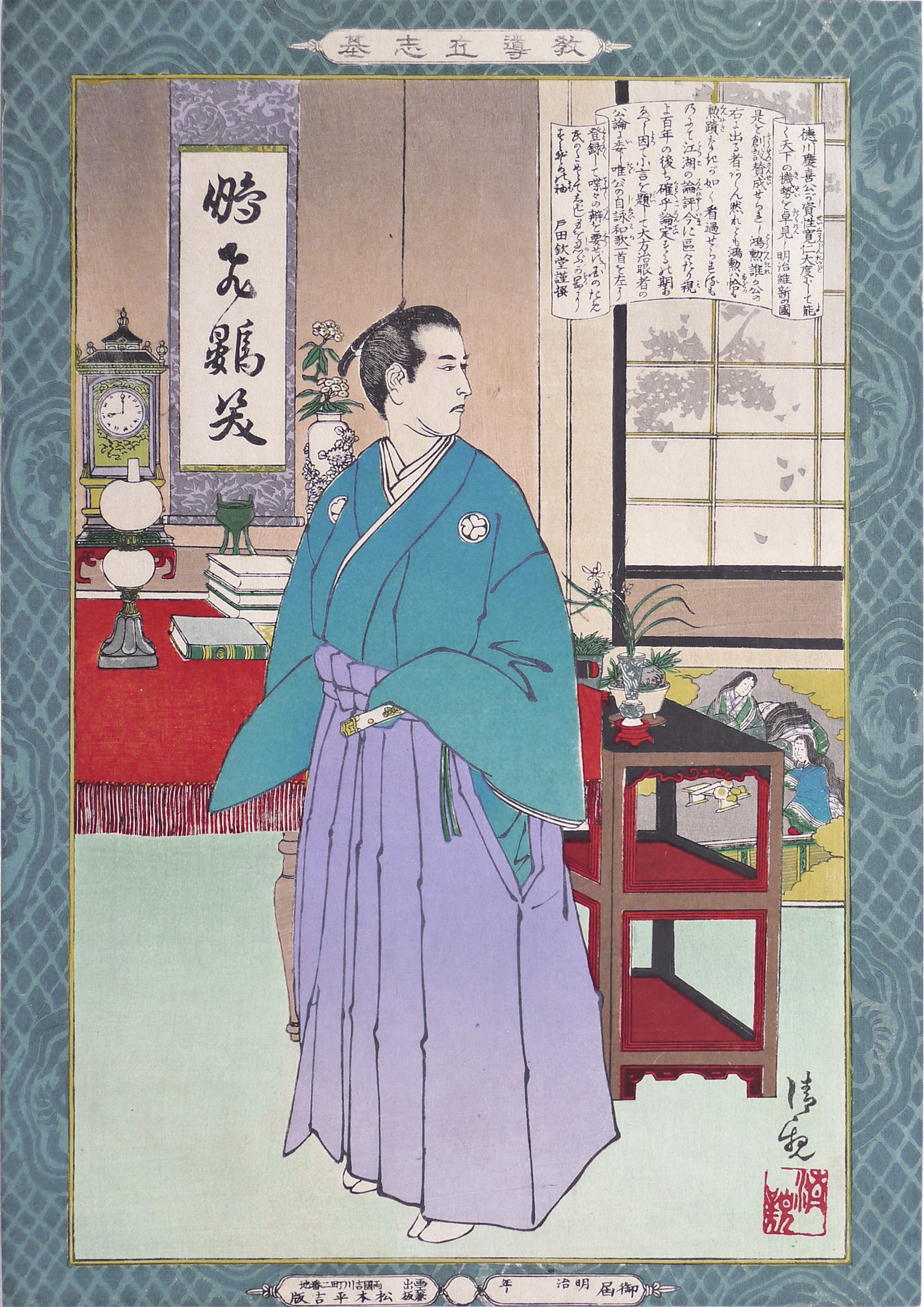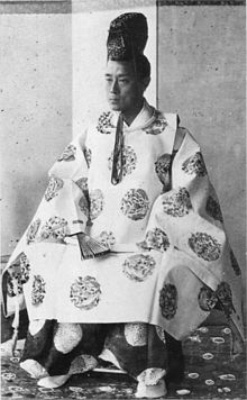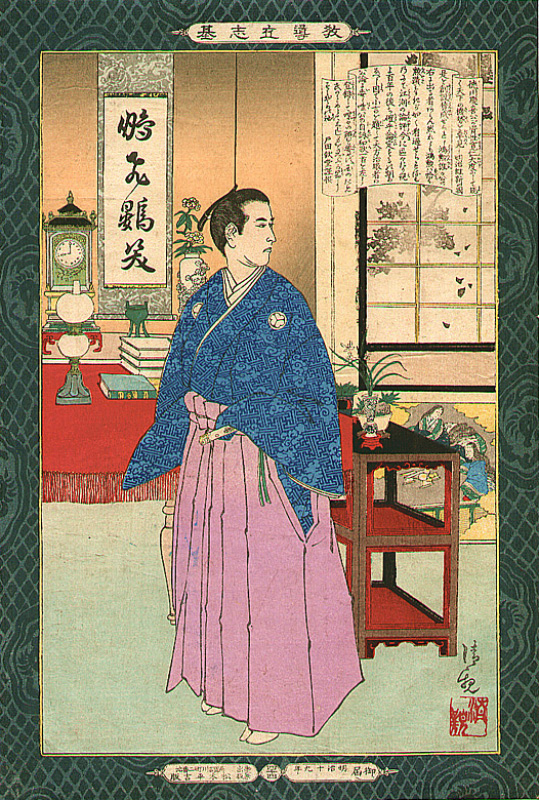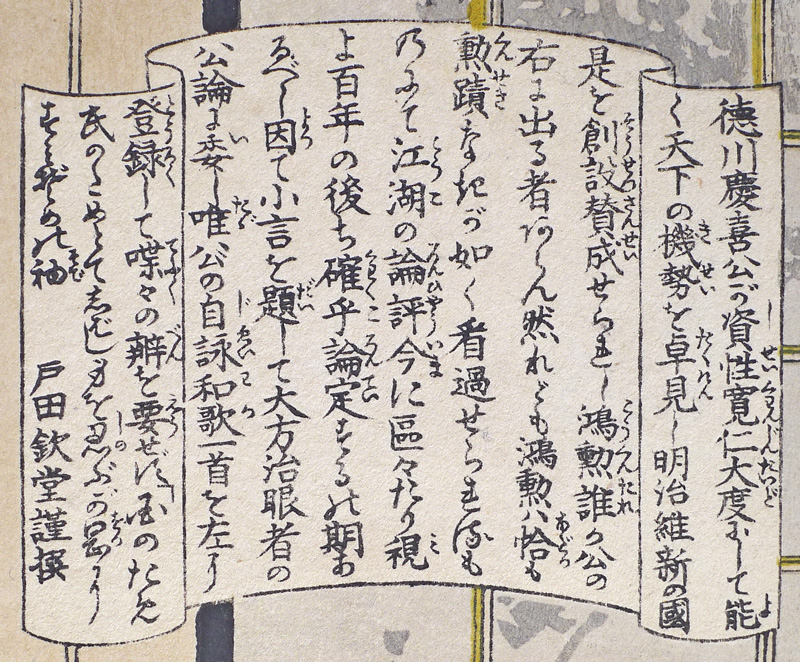About This Print
Print number 四十四 (44)1 in the series Instructive Models of Lofty Ambition portraying the last shogun Tokugawa Yoshinobu (1837-1913), who surrendered power to the Imperial Court, ushering in the Meiji Restoration. This particular print in the series must have engendered strong feelings in Kiyochika, as he had served Yoshinobu for several years as a young man.In this print, Yoshinobu is surrouned by the old (possibly a scene from The Tale of Genji to his left) and the new (a clock to his right) and books, pointing to his learning and intelligence. Yoshinobu seems to be glancing towards the window, outside of which falling leaves suggest the end of Tokugawa power.
44 Tokugawa Yoshinobu 徳川慶喜
教導立志基 四十四徳川慶喜 小林清親 1886年
Transcription: [scroll text by 戸田欽堂]
“徳川慶喜公が資性寛仁大度にして能く天下の機勢を卓見し明治維新の國是を創設賛成せられし鴻勲誰か公の右に出る者あらん 然れども鴻勲ハ恰も勲蹟なきが如く看過せられるも乃にて江湖の論評今に區々たり視よ百年の後ち確乎論定するの期あるべし因て小言を題して大方治眼者の公論に委し唯公の自詠和歌一首を左に登録して喋々の辯を要せず「国のため民のためとてしばし身を 忍ぶが?なり すみぞめの袖 戸田欽堂 謹撰”
Tokugawa Yoshinobu
Source: Sources of Japanese Tradition: Volume 2, 1600 to 2000, Wm. Theodore de Bary, Carol Gluck, DonaldKeene, Columbia University Press, 2005, p. 670-671; Wikipedia http://en.wikipedia.org/wiki/Tokugawa_Yoshinobu
While the print's scroll describes the many personal attributes of Yoshinobu, his fame was in being the last shogun, who on November 9, 1867, after a little more than a year in power, handed political and military rule to the emperor and the domains and the daimyo who spearheaded the "imperial restoration" and the overthrow of the shogunate.
In his declaration Yoshinobu wrote:
My ancestor [Tokugawa Ieyasu] received more confidence and favor from the Court than any of his predecessors, and his descendants have succeeded him for mare than two hundred years. Though I fill the same office, almost all the acts of the administration are far from perfect, and I confess ti with shame that the present unsatisfactory condition of affairs is due to my shortcomings and incompetence. Now that foreign intercourse becomes daily more extensive, unless the government is directed from one central authority, the foundations of the state will fall to pieces. If, however, the old order of things be changed, and the administrative authority be restored to the Imperial Court, and if national deliberations be conducted on an extensive scale, and the Imperial decision be secured, and if the empire be supported by the efforts of the whole people, then the empire will be able to maintain its rank and dignity among the nations of the earth.
After various political machinations and military encounters the restoration of military and political power to the emperor, known as the Meiji Restoration, was declared on January 3, 1868. Yoshinobu was to be sent into a quiet exile and then restored to respectability in later life by being made a prince in 1902 and serving in the House of Peers until 1910.
About The Series "Kyōdō risshi no motoi"
Notes:
This series ran between October 1885 and November 1890 and featured a long list of heroes and heroines, from antiquity to contemporary times, who were regarded as standards of moral leadership and self-realization.
This series of 58 prints,1 plus a table of contents sheet (目録), were originally published between October 1885 and November 1890 by the Tokyo publisher Matsuki Heikichi 松木平吉.2 The table of contents sheet issued by the publisher states that "fifty prints make up the complete set (五十番揃)". Three prints not in the initial release were added over the five year publication period, as were five redesigns of original prints, eventually increasing the total print count to 58. The seven artists contributing prints were Kobayashi Kiyochika (1847-1915) [20 prints], Mizuno Toshikata (1866-1908) [16 prints], Inoue Tankei (Yasuji) (1864-1889) [13 prints], Taiso (Tsukioka) Yoshitoshi (1839-1892) [5 prints], Yōshū Chikanobu (1838-1912) [2 prints], Toyohara Kunichika (1835–1900) [1 print], and Hachisuka (Utagawa) Kuniaki II (1835-1888) [1 print]. All the artists, with the exception of Yōshū Chikanobu, are listed in the top scroll of the table of contents sheet. Various colors (including blue, blue/green, and tan/brown) were used for the decorative border, and in 1902 the series was re-issued by Matsuki without borders.
Brief texts contained within a scroll-like cartouche appearing on each print provide historical details. The scroll composer's name is given at the end of the scroll text. The “lofty ambition” of the title is a Confucian concept, originally from Mencius, meaning “righteous determination that would inspire others.” The market for the series probably included former samurai, ambitious youth, and conservative intellectuals.
"[W]hen it was completed in 1890 the publisher was singled out for special recognition by the government for having sponsored such noble subject matter."3
1 The Tokyo Metropolitan Library online collection shows 50 prints and a Table of Contents sheet. The Table of Contents lists the titles of 50 prints. Smith in Kiyochika Artist of Meiji Japan identified 52 prints. I have identified 58 prints from this series including five prints (Ikina, Michizane Sugiwara, Kesa Gozen, Soga Brothers and Hokiichi Hanawa) that were re-designed and re-printed, likely due to damaged or lost blocks.
2 Robert Schaap notes in Appendix II, p. 166 of Yoshitoshi, Masterpieces from the Ed Freis Collection, Chris Uhlenbeck and Amy Reigle Newland, Hotei Publishing, 2011 that the series originally appeared as newspaper supplements.
3 The World of the Meiji Print: Impressions of a New Civilization, Julia Meech-Pekarik, Weatherhill, 1986, p. 122.
Print Details
| IHL Catalog | #1068 |
| Title or Description | Tokugawa Yoshinobu i徳川慶喜 |
| Series | “Instructive Models of Lofty Ambition” (Kyodo risshiki 教導立志基) [note: series title also listed as 'Kyodo Risshi no Moto', ‘Kyodo risshi no motoi’, ‘Kyōdō risshi ki’ and variously translated as “Moral of success” or “Foundations of learning and achievement” or “Self-made Men Worthy of Emulation”' or “Examples of Self-made Leaders” or "Paragons of instruction and success"] |
| Artist | Kiyochika Kobayashi (1847-1915) |
| Signature |  |
| Seal | Kiyochika 清親 (see above) |
| Publication Date | 1886 |
| Publisher | Matsuki Heikichi (松木平吉) proprietor of Daikokuya Heikichi [Marks: seal not shown; pub. ref. 029] click on image to enlarge (from right to left) publishing and printing date: 御屆 明治 年 [notification delivered, Meiji [blank] assigned number within series: [blank on this print but print 44 (四十四) in the series] publisher information: 画工兼 出板 両国吉川町二番地 松木平吉 版 [artist and publisher Ryōgoku Yoshikawachō 2-banchi Matsuki Heikichi han] |
| Engraver | |
| Impression | excellent |
| Colors | excellent |
| Condition | excellent - Japanese album backing paper |
| Genre | ukiyo-e; rishki-e; kyōiku nishiki-e |
| Miscellaneous | print 44 (四十四) in the series; position 46 in the Table of Contents. Number is omitted from this print. |
| Format | vertical oban |
| H x W Paper | 13 7/8 x 9 3/4 in. (35.2 x 24.8 cm) |
| H x W Image | 12 9/16 x 8 1/8 in. (31.9 x 20.6 cm) area inside brocade border |
| Literature | |
| Collections This Print | Tokyo Metropolitan Library 2443-K4; Tokyo Digital Museum (Tokyo Metropolitan Foundation forHistory and Culture) 96200407 |





